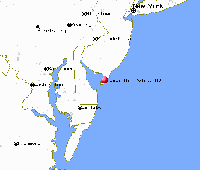Monarch Butterfly Migration Update: October 1, 2004
- Highlights From the Migration Trail
- New Jersey Study Shows Slowest Migration in 14 Years
- How’s the Weather Today in Mexico?
- Challenge Question #8
- Watching and Waiting at the Over-wintering Sanctuaries
- Un muy frío y mojado mensaje desde Angangueo
- How Many Times Can YOU Flap? Discussion of CQ #6
Highlights From the Migration Trail
The monarchs continued to push southward through the Midwest this week, with some impressive reports from Kansas, Nebraska and Oklahoma. Meanwhile, the migration has been remarkably unremarkable in the East. There, sightings of single monarchs seem to be the rule.
 |
Here are a few noteworthy comments from observers, along with some photos of monarchs on their way to Mexico!
09/29/04
Enid, OK
"The monarchs have been arriving all week on northern breezes,"
says Elbert Wheeler. "Perhaps a thousand or more, spread over six
acres but concentrated in pecan, hedge and elm trees. They are using
the same roost as in years past. Just south of our house."
09/28/04 Oklahoma City, OK
"We are seeing an influx of monarchs in the Oklahoma City, OK area
today. I checked the butterfly garden at the Oklahoma City Zoo around
5:00 p.m. and counted about 75-100 trying to settle in along a nearby
hillside in the elms, cedars, and hackberries."
09/29/104 Orwigsburg, PA
"So far at Hawk Mountain we have counted only 70 Monarchs when
our usual average at this date should be over 1,000," noted the
Senior Monitoring Biologist at Hawk Mountain Sanctuary. Hawk Mountain
Sanctuary is located along the Appalachian Flyway in southeastern Pennsylvania.
 |
 |
 |
| Second grade students tagging monarchs in the Oklahoma City Zoo's Butterfly Garden | ||
All monarch sightings that have been reported are displayed on our MapServer. You can “click” to read each observer’s comments.
 |
 |
 |
| Peak
Migration Sightings |
Sightings of Overnight Roosts |
New Jersey Study Shows Slowest Migration in 14 Years
For the 14th year, monarchs are being counted every single day as they migrate through Cape May, New Jersey. This year, after four weeks, the average number of monarchs seen per hour of observation is only 7.41 butterflies.
Here are the data that have been collected since 1992 as of Week #4 each year:
Try This!
-
Make a chart of the migration rate each year.
-
Which year was the migration rate the highest? The lowest?
-
Write the years in order, from highest to lowest migration rate.
-
What is the average migration rate?
-
How does this year’s migration rate compare to the average?
How’s the Weather Today in Mexico?
As you know, winter is on its way and the monarchs are moving southward to escape it.
How do you picture the weather in the monarch’s winter home? Before reading further, describe the weather in your science journal as you imagine it. How warm do you think it gets during the day? How cool do you think temperatures are at night? Give the reasoning behind your predictions.
Next, read today’s weather report for Angangueo. (Angangueo is a small town seated at the base of the mountains of the two largest monarch sanctuaries.) Then answer Challenge Question #8:
-
Daily Weather Forecast for Angangueo, Michoacan, Mexico
"What are the high and low temperatures predicted for Angangueo today? How are the temperatures different than those you predicted?"
(To respond to this question, please follow the instructions below.)
 |
| María Estela Romero with her daughter, Laura Emila. |
"A very wet and cold second report from Angangueo," begins María Estela Romero. "Yes, all coming to Angangueo at this time of the year shall be totally wet and very cold. We are having the hardest rains we have had during the last four months. No news about any Monarch seen in the sky."
"Un muy frío y mojado mensaje desde Angangueo. Efectivamente, todo lo que en este momento vaya desde aquí será totalmente mojado y frío. El pasado 23 y 25 de Septiembre, tuvimos las dos más intensas lluvias que hubiéramos tenido durante los cuatro últimos meses y las mas intensas que hubieramos visto en los últimos años. No hay ninguna noticia en cuanto a ninguna Monarca sobrevolando el cielo."
How Many Times Can YOU Flap?
Discussion of Challenge Question #6
After looking at the energy costs of flapping flight we asked, "If a monarch flaps its wings 5 to 12 times per second, how many times per minute does it flap? How many times can you flap your arms in a minute?"
Careful monarch math reveals that monarchs can flap their wings between 300 and 720 times per minute. WOW!
"Our 3rd grade class at the JC Caruso School in Keansburg, New Jersey tested their 'wings' against the monarch," wrote teacher Bruce England. "The number of flaps the kids were able to do varied. Most were able to do over 100, but some only got around 75 or so. They learned that the monarchs are certainly more capable of flight than they were!"
Only 14 more butterfly-making days before the Symbolic Migration deadline. Don't be late! Butterflies received after the postmarked deadline cannot migrate.
 |
 |
 |
1. Address an e-mail message to: jn-challenge-monarch@learner.org
2. In the Subject Line of the message write: Challenge Question #8
3. In the body of the message, answer the question above.
The Next Monarch Migration Update Will Be Posted on October 8, 2004.
Copyright
2004 Journey North. All Rights Reserved. Please send all questions, comments,
and suggestions to jn-help@learner.org
![]()
![]()
![]()
![]()
![]()
![]()








